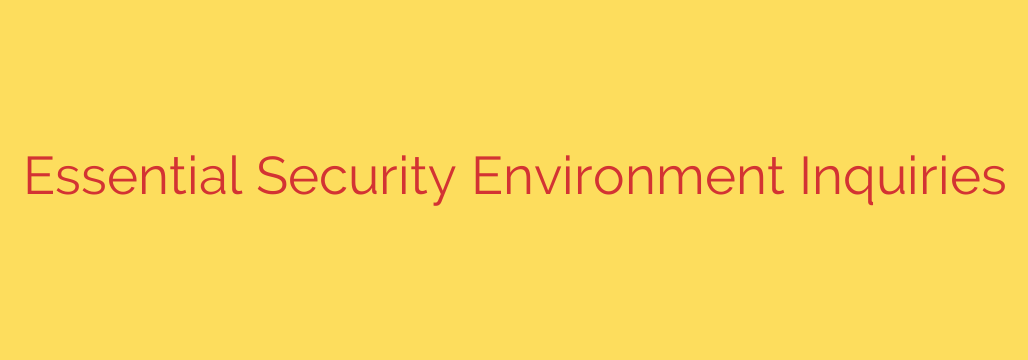
Fortify Your Digital Defenses: The Essential Cybersecurity Checklist
In today’s digital landscape, the question isn’t if your business will face a cyber threat, but when. A reactive approach to security is a recipe for disaster. To truly protect your data, reputation, and bottom line, you must adopt a proactive mindset. This begins with asking the right questions to understand your security posture from every angle.
A thorough internal audit is the foundation of any strong cybersecurity strategy. By regularly evaluating your environment, you can identify weaknesses before malicious actors do. Here is an essential checklist of critical questions every organization must ask to fortify its digital defenses.
1. Do You Have a Complete Inventory of Your Digital Assets?
You can’t protect what you don’t know you have. The first step in securing your environment is creating a comprehensive inventory of all your assets. This isn’t just about computers and servers; it includes all software, cloud services, mobile devices, and, most importantly, data.
Ask your team: Where is our most sensitive data stored? Which applications are critical for our operations? What hardware connects to our network? Answering these questions allows you to create and maintain a comprehensive asset inventory, which is the map you’ll use to build your defenses. Without it, you’re operating in the dark.
2. Who Has Access to Your Data and Systems?
Once you know what you have, you need to know who can touch it. Unchecked user permissions are a leading cause of data breaches, whether through malicious intent or a compromised account. The goal is to enforce the principle of least privilege.
This principle dictates that users should only have access to the specific information and systems required to do their jobs—and nothing more. Regularly review all user accounts and access permissions to ensure they are still necessary. When an employee changes roles or leaves the company, their access must be adjusted or revoked immediately. Strong access controls are not about mistrust; they are about minimizing your attack surface.
3. How Are You Managing Vulnerabilities and Threats?
Cybercriminals love to exploit known vulnerabilities in outdated software. A single unpatched application or server can be the unlocked door they need to walk right into your network. A passive approach to updates is insufficient.
Your organization needs a formal process for identifying, evaluating, and fixing security weaknesses. This involves regular vulnerability scanning across your network and applications. Establish a robust patch management program to ensure that critical security updates are applied as quickly as possible. This proactive maintenance closes security gaps before they can be weaponized against you.
4. Is Your Sensitive Data Properly Protected?
Not all data is created equal. Customer information, financial records, and intellectual property require the highest level of protection. It’s crucial to know how this data is secured both when it’s being stored (at rest) and when it’s being transmitted (in transit).
Encryption is a non-negotiable security control. Encrypt sensitive data both at rest on your servers and in transit across the network. Furthermore, robust backup systems are essential for resilience. Don’t just have backups—test them. Regularly test your data backup and recovery procedures to ensure you can restore operations quickly after a ransomware attack or system failure.
5. What Is Your Plan for a Security Incident?
Hope is not a strategy. Despite your best efforts, a security incident may still occur. How your team responds in the first few hours can make the difference between a minor issue and a catastrophic breach. A well-defined plan is essential for a calm, coordinated, and effective response.
Develop and practice a formal Incident Response Plan (IRP). This plan should clearly outline roles and responsibilities, communication protocols (both internal and external), and the technical steps required to contain and eradicate a threat. Running tabletop exercises or simulations helps ensure everyone knows their role when a real crisis hits.
6. Are Your Employees a Security Asset or a Liability?
Your employees can be your greatest security strength or your weakest link. A well-trained employee can spot a phishing email and report it, stopping an attack in its tracks. An untrained employee might click a malicious link and unknowingly grant an attacker access to your entire network.
The human element cannot be ignored. Invest in ongoing security awareness training for all employees. This training should be engaging and relevant, covering topics like phishing, password hygiene, and social engineering. Regular phishing simulations can help measure the effectiveness of your training and reinforce good security habits.
By systematically working through these essential questions, you can build a clear and honest picture of your cybersecurity posture. This process isn’t a one-time project; it’s a continuous cycle of assessment, improvement, and vigilance. A strong defense is an active one, and it starts with knowing where you stand.
Source: https://go.theregister.com/feed/www.theregister.com/2025/07/23/prelude_three_security_questions/








